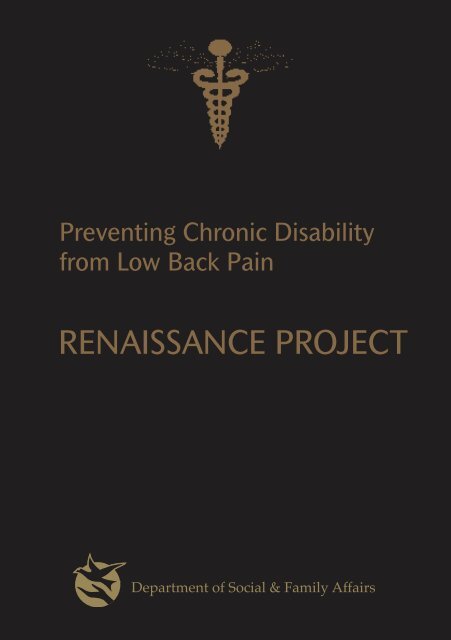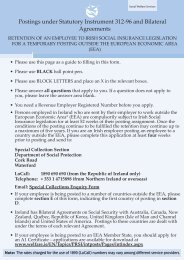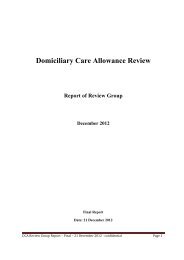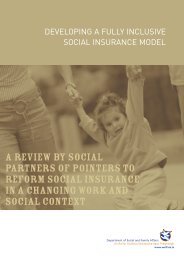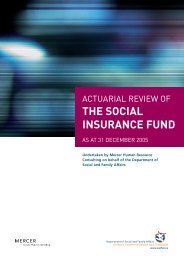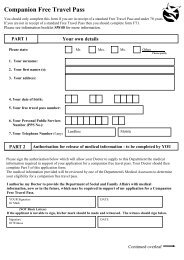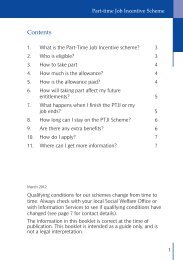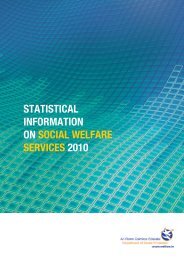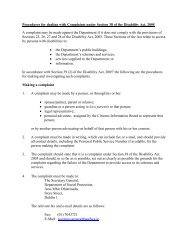Preventing Chronic Disability from Low Back Pain - Welfare.ie
Preventing Chronic Disability from Low Back Pain - Welfare.ie
Preventing Chronic Disability from Low Back Pain - Welfare.ie
- No tags were found...
Create successful ePaper yourself
Turn your PDF publications into a flip-book with our unique Google optimized e-Paper software.
<strong>Preventing</strong> <strong>Chronic</strong> <strong>Disability</strong><strong>from</strong> <strong>Low</strong> <strong>Back</strong> <strong>Pain</strong>RENAISSANCE PROJECT
<strong>Preventing</strong> <strong>Chronic</strong> <strong>Disability</strong><strong>from</strong> <strong>Low</strong> <strong>Back</strong> <strong>Pain</strong>RENAISSANCE PROJECTBAILE ÁTHA CLIATHARNA FHOILSIÚ AG OIFIG AN tSOLÁTHAIRLe ceannach díreach ónOifig Dhíolta Foilseacháin Rialtas,TEACH SUN ALLIANCE, SRÁID THEACH LAIGHEAN, BAILE ÁTHA CLIATH 2,nó trid an bpost óFOILSEACHÁN RIALTAS, AN RANNÓG POST-TRÁCHTA,51 FAICHE STIABHNA, BAILE ÁTHA CLIATH 2.(Teil: 01 647 6843)nó trí aon díoltáir leabhar.DublinPUBLISHED BY THE STATIONERY OFFICETo be purchased directly <strong>from</strong> theGOVERNMENT PUBLICATIONS SALES OFFICE,SUN ALLIANCE HOUSE, MOLESWORTH STREET, DUBLIN 2,or by mail order <strong>from</strong>GOVERNMENT PUBLICATIONS, POSTAL TRADE SECTION,51 ST. STEPHEN’S GREEN, DUBLIN 2.(Tel: 647 6843)or through any bookseller.€2.50© GOVERNMENT OF IRELAND 2004
AcknowledgmentsThe author wishes to thank the following:Professor Gordon Waddell CBE, Professor Kim Burton and Professor ManselAylward CB for their pioneering work in evidence-based back pain researchand disability evaluating medicine which inspired me to conceive this project.The working groups responsible for Occupational Guidelines for theManagement of <strong>Low</strong> <strong>Back</strong> <strong>Pain</strong>, Faculty of Occupational Medicine, RoyalCollege of Physicians (UK) and the European Guidelines for the Managementof nonspecific <strong>Low</strong> <strong>Back</strong> <strong>Pain</strong> on which the premise of this project is based.The Board of the Faculty of Occupational Medicine of the Royal College ofPhysicians of Ireland and the Council of the European Union of Medicine inAssurance and Social Security (EUMASS) and the Health & Safety Authoritywho have agreed to endorse the European Guidelines.Paul Morrin BA Mod. Econ., MSc for his expert statistical analysis.The staff of the DSFA’s Benefits Branch and Medical Rev<strong>ie</strong>w and AssessmentSection for their effic<strong>ie</strong>ncy in selecting and processing cases.The DSFA’s medical staff whose dedicated involvement in the project ensuredthe highest professional standards.Minister Mary Coughlan, TD, whose personal interest in reducing chronicdisability <strong>from</strong> low back pain enabled this project to be undertaken.4
Minister’s Foreword<strong>Back</strong> pain is not a new phenomenon, it has been knownthroughout recorded history – and in recent years therehas been a marked increase in chronic disability resulting<strong>from</strong> low back pain.Despite advances in health and safety legislation, ergonomics and other areas chronicdisability <strong>from</strong> lower back pain is increasing.The Renaissance Project set out to identify whether early intervention usinginternational evidence-based guidelines would decrease the incidence of progressionto chronic disability.The Report of the Renaissance Project demonstrates my Department’s growinginvolvement in broadening its scope beyond the provision of income support.The outcome of the project has shown that early intervention leads to a reductionin chronic disability resulting <strong>from</strong> lower back pain. It means a quicker return to workfor those who are temporarily afflicted by lower back pain. This will be for the benefitof workers, their famil<strong>ie</strong>s who shoulder the burden of support, and employers.There will also be benefits to soc<strong>ie</strong>ty through cost savings in health care, reducedabsenteeism <strong>from</strong> work and resulting decreased production and reduced numbersgoing on to long-term illness benefit schemes.Implementing this report will require a multi-faceted response, and I look forward toworking with the required coalition of professionals in a wide range of representativebod<strong>ie</strong>s to spread the message that early intervention works in dealing with lowerback pain.Finally, I would like to place on the record my gratitude to all those who participatedin the project.Mary Coughlan, TDMinister for Social and Family Affairs 5
RENAISSANCE PROJECT<strong>Preventing</strong> <strong>Chronic</strong> <strong>Disability</strong> <strong>from</strong> <strong>Low</strong> <strong>Back</strong> <strong>Pain</strong>1. INTRODUCTION<strong>Back</strong> pain is not a new phenomenon. Man has suffered <strong>from</strong> back painthroughout recorded history. There is no evidence that back pain has increasedin incidence or severity throughout the ages. Despite this, however, in Westernsoc<strong>ie</strong>ty, particularly in the past two decades, there has been a marked increasein chronic disability resulting <strong>from</strong> low back pain. In the hope of arresting, andperhaps, reversing this trend the Renaissance Project was conceived. Theconduct, conclusions and recommendations of the project are outlined below.2. DEFINITIONS<strong>Pain</strong> The International Association for the Study of <strong>Pain</strong> defined pain as“an unpleasant sensory and emotional exper<strong>ie</strong>nce associated with actualor potential tissue damage, or described in terms of such damage”.<strong>Low</strong> <strong>Back</strong> <strong>Pain</strong> (LBP) is pain in the lumbo-sacral region, buttocks and thighs.<strong>Disability</strong> The World Health Organisation (WHO) defined disability as “anyrestriction or lack of ability to perform an activity in the manner or withinthe range considered normal for a human being”.<strong>Chronic</strong> <strong>Disability</strong> is disability lasting continuously for a period of 3 monthsor more.Diagnostic Triage diagnostic tool for the differential diagnosis of LBP.See Appendix A for further details.3. BACKGROUND3.1 Problem Identif<strong>ie</strong>d6<strong>Chronic</strong> disability, arising <strong>from</strong> LBP, is increasing. This trend is common to mostindustrialised countr<strong>ie</strong>s and worryingly continues in spite of Health and Safety
legislation, improved ergonomic practice, automation and advances intechnology and medical sc<strong>ie</strong>nce.In addition to the human suffering involved there are substantial financialimplications involving healthcare cost, absenteeism, loss of production,insurance and sickness benefit costs. See Appendix B for increase in numbersand expenditure in social welfare illness-related schemes in Ireland. Aproportion of this increase (approximately 27%) is due to musculo-skeletalproblems, the majority of which is due to LBP.This is not solely a medical problem, there are many players involved who needcourageously, objectively and critically to reassess their particular roles in themanagement of low back pain. This presents a challenge to all of the playersinvolved, the main players being:●●●●●●●●●General Public, its Attitudes and Bel<strong>ie</strong>fsPerson with LBPMedical ProfessionLegal ProfessionEmployersUnionsThe Health and Safety AuthorityInsurance IndustrySocial <strong>Welfare</strong> Illness-Related Schemes3.2 Re-Assessment of Role of Social <strong>Welfare</strong> Illness-Related SchemesIn facing its challenge the Department of Social and Family Affairs (DSFA)decided to re-assess its particular role in the management of LBP.7
In appreciation of the facts that:a) while necessary to the maintenance of the integrity of soc<strong>ie</strong>ty - by providingincome support for those who cannot work - illness benefit schemes can, bytheir nature, facilitate, reinforce and perpetuate disability,b) the longer a person is off work with LBP, the lower their chances of everreturning to work, andc) most people with simple LBP are able to return to work despite persistentsymptoms, have a better outcome and less chance of re-injury than thosewho rest and avoid work,the DSFA decided to address the problem in the acute, sub-acute and chronicstages by implementing the Renaissance Project, so called, so as to rekindle theHippocratic Principle ‘first, do no harm’.The acute stage was considered to be <strong>from</strong> 0 to 6 weeks, the sub-acute <strong>from</strong> 6weeks to 3 months and the chronic for durations in excess of 3 months.Priority was afforded to the acute stage in the first instance. We would attemptto ‘turn off the tap’ as it were, rather than ‘continuously mop up the floor’.The sub-acute and chronic stages are to be addressed with job retention,rehabilitation and work re-integration schemes.4. AIM OF PROJECTThe aim of the project was to determine if early intervention, usinginternational evidence-based guidelines in the assessment of claimants withLBP, would decrease the incidence of progression to chronic disability.Statements <strong>from</strong> international guidelines are given in Appendix C.8
5. METHODIn the period January to June 2003 new <strong>Disability</strong> Benefit (DB) and InjuryBenefit (IB) claimants, aged 20 to 50 years in Dublin and Cork who werecertif<strong>ie</strong>d by their General Practitioners to be suffering <strong>from</strong> LBP, were targetedfor early intervention. Approximately 3,300 new claims were involved. Theclaims covered in the project areas account for approximately 34% of all newLBP claims for persons aged 20-50 nationwide in 2003.A control group of cases, similar to those targeted in the project, for the periodJanuary to June 2002 was used to make some comparisons with the results ofthe project.6. PROCESSING THE TARGETED CLAIMSIn processing the 3,300 claims in the project the following outcomes occurred:●●●●As expected, 1,700 claimants (51.5%) returned to work within 4 weeksof their own volition.Approximately 1,600 claimants were selected for early referral and invitedto attend for medical assessment at 4 to 6 weeks <strong>from</strong> date of claim.(Hitherto, referral would have taken a considerably longer period and theproblem would have gone beyond the acute stage).Interestingly, on receipt of invitation to attend for assessment, a significantproportion of the 1,600 claimants – 1,000 (62.5%) – came off benefit andreturned to work.The remaining 600 (approximately) were assessed using the ‘DiagnosticTriage’ system of assessment.9
7. MEDICAL ASSESSMENTSAs part of the project it was necessary to train medical assessors in the use ofthe Diagnostic Triage which categorises LBP into 3 main groups, to determinemanagement.The 3 groups are:1. Simple <strong>Back</strong> <strong>Pain</strong> – majority of cases (approximately 95%), prognosis isexcellent, with recovery expected in days to weeks.2. Nerve Root <strong>Pain</strong> – 3-5% of cases, prognosis is moderate, with recoveryexpected in weeks to months, only a minority requiring surgery3. Potential Serious Spinal Pathology – 1-2% of cases, which includes fractures,infections, inflammatory conditions and tumours. Prognosis depends on thediagnosis.Cases in the Simple <strong>Back</strong> <strong>Pain</strong> category were considered for work capacity.Fitness for work was determined not solely through categorisation as SimpleLBP. Medical assessors also took into consideration other relevant factors suchas the severity of the symptoms, type of work involved and potential for workrestriction or accommodation in the workplace.Cases in the other categor<strong>ie</strong>s Nerve Root <strong>Pain</strong> and Potential Serious SpinalPathology were considered to be unfit for work for varying periods, dependingon the diagnosis.Detailed records of medical assessments were held for analysis which includeda breakdown by gender, work type and age group. See Appendix D.10
8. RESULTSThe incidence of progression <strong>from</strong> the acute Simple LBP to chronic disabilityemploying the method described above was reduced significantly; 64 per centof the LBP cases assessed under the project were declared capable of work,compared to circa 20 per cent of all claimants with a var<strong>ie</strong>ty of illnesses,including LBP, who were assessed under the DB/IB schemes in 2002. SeeAppendix E.Under the DB/IB schemes where a person is found capable of work s/he canappeal against this finding. When this occurs the person undergoes a secondassessment by a different assessor who can find the person capable orincapable of work. Under the project fewer people appealed against thecapable decision than for all DB/IB claims in 2002 (44% versus 61%). Followingthe second assessment the percentage of people found incapable was 17%under the project. For all DB/IB claims in 2002 the percentage found incapableat the second assessment was 49%. See Appendix F.In comparisons with a similar group over a similar period in the previous year(the control group) there was a circa 40% reduction in claims progressing tolong duration. See Appendices G and H.A secondary benefit of the project is that the reduction in duration resulted in areduction in expenditure on the DB/IB schemes. If the patterns in expenditurein the project were retrospectively appl<strong>ie</strong>d to expenditure in 2002 the estimatedsavings that would have occurred in DB/IB expenditure on LBP claims in 2002are shown in Appendix I.11
9. PROMOTING THE RENAISSANCE PROJECTTo assist in the dissemination of the guidelines on which the project is basedand to encourage their implementation in other areas the author has:●●made the ‘<strong>Back</strong> Book’, published by TSO (the UK Stationery Office),available, free of charge, to DSFA customers and relevant organisationsobtained commitments <strong>from</strong>1) the Board of the Faculty of Occupational Medicine of the Royal Collegeof Physicians of Ireland2) the Health and Safety Authority3) the Council of the European Union of Medicine in Assurance and SocialSecurity (EUMASS)to endorse the European Guidelines on Best Management of Acute <strong>Low</strong> <strong>Back</strong><strong>Pain</strong>, to assist in their dissemination and to encourage their implementation●●Made several presentations at conferences nationally and internationallyto medical and relevant non-medical aud<strong>ie</strong>ncesContributed to the media dissemination of the guidelines.10. CONCLUSIONSThe Renaissance Project employing early intervention by the DSFA has resultedin a significant reduction in the progression to chronic disability <strong>from</strong> simpleLBP. The impact of this early intervention in the acute stage should result notonly in the improved health of LBP suffers in the long term but also indecreased health care costs, reduced absenteeism, increased production andsignificant savings in long-term illness benefit schemes.12
11. RECOMMENDATIONSWhereas, unilateral intervention by the DSFA has proved to be effectivein reducing chronic disability <strong>from</strong> LBP, it is only part of a solution to amulti-faceted problem.Ideally, to sustain and improve the effectiveness of early intervention a coalitionof disability managers, mainly representing those players listed in 3.1 above,needs to be formed. This coalition should implement a universally agreed,evidence-based protocol for best management of LBP.In this regard some initial progress has been made. The Health and SafetyAuthority, in association with the DSFA, is to launch a poster campaign toeffect a change in the attitudes and bel<strong>ie</strong>fs of the general public regarding LBP.This initiative has been endorsed by the majority of the role players.12. EXTENDING THE PRACTICE OF EARLY INTERVENTIONAs a consequence of the results being ach<strong>ie</strong>ved in the project it was decided toextend beyond June 2003 the processing of LBP cases in the manner describedabove This involved the targeting of a further 8,400 cases in Dublin, Cork andGalway in the period July 2003 to June 2004. Approximately 3,700 of thesecases have been referred for assessment and the findings to date haveremained consistent with those in the project. (See Appendix J).13
14APPENDICES
APPENDIX AAPPENDIX A1: DIAGNOSTIC TRIAGELBP is very common, affecting 60-80% of the population at some stage.Although rarely serious, it can, however, be the presenting symptom of seriousspinal disease.After excluding non-spinal causes of LBP the next priority is, therefore, todistinguish between non-serious and potentially serious causes of LBP.This distinction is essential to determine the management of LBP.Fundamental to this distinction is the use of Diagnostic Triage.This diagnostic tool is internationally recognised and recommended.It is based on detailed history taking and physical examination and designedto differentiate between LBP caused by possible serious spinal pathology,nerve root pain (sciatica) caused usually by disc prolapse (slipped disc)and Simple LBP.Simple LBP is a term used to describe LBP which is not attributable to possibleserious spinal pathology or nerve root pain.15
APPENDIX A2:FORMS DESIGNED FOR USE IN PROJECTThe following 3 forms were designed to:A. assist the medical assessors in the differential diagnosis of LBPB. assess the degree, if any, of resulting disability andC. ach<strong>ie</strong>ve and maintain consistency.A. DIAGNOSTIC TRIAGE1. SIMPLE LOW BACK PAINYESNO● 20 –55 YRS ❏ ❏● L/S region, buttocks and thighs ❏ ❏● Mechanical in nature ❏ ❏● Pat<strong>ie</strong>nt well ❏ ❏2. NERVE ROOT PAIN● Unilateral leg pain worse than low back pain ❏ ❏● Radiates generally to foot or toes ❏ ❏● Numbness & paraesthesia in same direction ❏ ❏● Nerve irritation signs – SLR restricted ❏ ❏● Nerve compression signs – motor, sensory ❏ ❏or reflex changes16
YESNO3. POTENTIAL SERIOUS SPINAL PATHOLOGY● Age: onset under 20 or over 55 years ❏ ❏● Violent trauma relative to age, e.g. fall <strong>from</strong> height ❏ ❏in young pat<strong>ie</strong>nt or heavy lift by older person withosteoporosis could indicate fractures● Constant, progressive non-mechanical pain ❏ ❏● Thoracic pain ❏ ❏● Past history – carcinoma, immune suppression ❏ ❏(<strong>from</strong> use of steroids, or HIV)● Systemically unwell, weight loss, infection ❏ ❏● Persisting severe restriction of lumbar flexion ❏ ❏● Widespread neurological signs & symptoms ❏ ❏● Structural deformity ❏ ❏3.1 INFLAMMATORY DISORDERS(Ankylosing spondylitis & related disorders)● Marked morning stiffness ❏ ❏● Persisting limitation of spinal movements ❏ ❏● Peripheral joint involvement ❏ ❏● Iritis, skin rashes (psoriasis), colitis, urethral discharge ❏ ❏● Family history ❏ ❏17
3.2 CAUDA EQUINA SYNDROMEYES NO● Difficulty with micturition ❏ ❏● Sphincter disturbance ❏ ❏● Gait disturbance ❏ ❏● Saddle anaesthesia (pelvic area) ❏ ❏18
B. DISABILITY ASSESSMENT: DEGREES OF RESULTINGDISABILITYThe degrees of resulting disability are depicted on this ability/disability profile,which affords a readily visible and reasonably accurate portrait, not only ofresulting disability but also and very importantly of, residual functional capacity.The degrees of disability are estimated as follows:Normal Mild Moderate Severe Profound0-5% 5-20% 20-50% 50-75% 75-100%Mental Health ❏ ❏ ❏ ❏ ❏Learning/Intelligence ❏ ❏ ❏ ❏ ❏Consciousness/Seizures ❏ ❏ ❏ ❏ ❏Balance/Co-ordination ❏ ❏ ❏ ❏ ❏Vision ❏ ❏ ❏ ❏ ❏Hearing ❏ ❏ ❏ ❏ ❏Speech ❏ ❏ ❏ ❏ ❏Continence ❏ ❏ ❏ ❏ ❏Reaching ❏ ❏ ❏ ❏ ❏Lifting/Carrying ❏ ❏ ❏ ❏ ❏Manual Dexterity ❏ ❏ ❏ ❏ ❏Bend/Kneel/Squat ❏ ❏ ❏ ❏ ❏Sitting ❏ ❏ ❏ ❏ ❏Standing ❏ ❏ ❏ ❏ ❏Climbing Stairs ❏ ❏ ❏ ❏ ❏Walking ❏ ❏ ❏ ❏ ❏19
C: MEDICAL REPORT ON BACK CONDITIONSurname: ________________ Initials: ____________ PPS No. _______________1. Is an appliance worn?(a) Type(b) Has the customer been instructed not to remove it?(c) If not was the appliance removed for the examination?2. (a) Posture(b) Gait(c) Spinal Curve(d) Deformit<strong>ie</strong>sIs the customer able to:(a) Tiptoe?(b) Squat?(c) Kneel?3. Site of any muscle spasm elicited4. <strong>Pain</strong> (a) Site and nature(b) Direction(c) Site of local tenderness5. Movements (Should never be permitted beyond the limit of comfort)(a) Flexion (Measured to tibial thirds and inches <strong>from</strong> the floor)(b) Extension(c) Lateral flexion (fingertips in relation to popliteal crease)(d) Rotation6. Is the customer able to touch toes sitting on couch?20
RightLeft7. Unassisted straight leg raising (lying down)8. Measurements(a) Thighs(4 inches above upper border of patella)(b) Calves(4 inches below tibial tuberosity)9. Central Nervous System(a) Knee jerks(b) Ankle jerks(c) Plantar responses(d) Sensory disturbance(e) Loss of power of dorsiflexion of hallux10. General observations and or other physicalsigns not shown above:21
APPENDIX BGROWTH IN ILLNESS SCHEMESThe Department of Social and Family Affairs (DSFA) operates variousillness-related schemes. These schemes are designed to:●●provide income support for people who, because of illness or injury,are unable to work or are suffering <strong>from</strong> a major disability or requireconstant care and attentionafford compensation to people who are deemed to have suffered a ‘lossof faculty’ as a result of injury at work or contracting a work-related disease.Some schemes are designed to cater for short-term illnesses, others forlong-term illnesses or incapacity.The number of recip<strong>ie</strong>nts of benefits/allowances <strong>from</strong> these schemes has risen<strong>from</strong> 100,000 in 1992 to 206,137 in 2003.The sharp increase in 1995 was due to the transfer of approximately 38,000recip<strong>ie</strong>nts of Disabled Person’s Maintenance allowance (DPMA) <strong>from</strong> theDepartment of Health to the DSFA, following its transfer the DPMA wasrenamed the <strong>Disability</strong> Allowance (DA).As expected, the trend in expenditure follows the trend in numbers which isgraphically depicted on the page opposite.22
Table B: Number of Recip<strong>ie</strong>nts and Expenditure onIllness Related Schemes, 1992-2002250,0001,6001,400200,0001,200No. of Recip<strong>ie</strong>nts150,0001,000800Expenditure (€m)600100,00040020050,00019921993199419951996Number of Recip<strong>ie</strong>ntsExpenditure (€m)199719981999200020012002023
APPENDIX CSTATEMENTS FROM INTERNATIONAL GUIDELINESFOR MANAGEMENT OF LBPThe following are some of the evidence-based statements derived <strong>from</strong>research and supported by strong evidence ***, that is, generally consistentfindings in multiple, high quality sc<strong>ie</strong>ntific stud<strong>ie</strong>s.*** Most adults (60-80%) exper<strong>ie</strong>nce LBP at some time.*** Care seeking and disability due to LBP depend more on complex individualand work-related psychosocial factors than on physical features or physicaldemands of work.*** Most workers with LBP are able to continue working or return to workwithin a few days or weeks, even if they have some residual or recurrentsymptoms, and they do not need to wait until they are completely pain free.*** The longer a worker is off work with LBP, the lower their chances of everreturning to work. Once a worker is off work for 4 to 12 weeks, they have a 10to 40% (depending on the setting) risk of still being off work at one year; afterone to two years absence it is unlikely they will return to any form of work inthe foreseeable future, irrespective of future treatment.*** In-pat<strong>ie</strong>nts with non-specific LBP, X-rays and MRI findings do not correlatewith clinical symptoms or work capacity.*** Advice to continue ordinary activit<strong>ie</strong>s of daily living (ADL) as normally aspossible despite the pain can give equivalent or faster symptomatic rel<strong>ie</strong>f, andleads to shorter periods of work loss, fewer recurrences and less work loss overthe following year than “traditional medical treatment” (advice to rest and ‘letpain be your guide’ for return to normal activity).24
APPENDIX DPROFILE OF PERSONS MEDICALLY ASSESSED DURING THERENAISSANCE PROJECTBreakdowns of persons assessed by gender, work type and age group are givenin the table below. Of those assessed, the majority were women, thoughsomewhat less so than for DB/IB claims in general. A relatively low share of thetotal group were in work situations described as ‘heavy’ by the medicalassessors. Finally, persons assessed were somewhat more likely to be inyounger age groups than otherwise for DB/IB claims.Table D: Profile of persons medically assessed under the RenaissanceProject, January - June 2003; profile of all DB/IB claims (personsaged under 50), December 2002Category Number of % of total All DB/IB claims, % of totalPersons assessed Dec. 2002 DB/IB claimsGenderMen 216 39.9% 10,980 31.5%Women 325 60.1% 23,891 68.5%Work typeLight 195 36.0% n.a.Moderate 251 46.4% n.a.Heavy 95 17.6% n.a.Age20-29 127 23.5% 6,431 18.4%30-34 112 20.7% 6,663 19.1%35-39 107 19.8% 7,514 21.5%40-44 99 18.3% 7,173 20.6%45-50 96 17.7% 7,090 20.3%Total assessed 541 34,87125
APPENDIX EOUTCOMES OF MEDICAL ASSESSMENTS (PROJECT VS ALL 2002DB/IB CLAIMS)For the table opposite it was not possible to do a comparison with the controlgroup because it was identif<strong>ie</strong>d retrospectively and detailed medical recordshad not been held for the claimants in the group. Comparisons had to be madeagainst all types of (DB/IB) claims in 2002.When claimants attended for assessment, the percentage of claimants foundincapable was much lower for LBP cases examined under the project thanthose assessed in 2002 for all DB/IB illnesses. Conversely the percentage foundcapable of work was much higher. This pattern is maintained through theappeals procedure. See Appendix F.26
80%Table E: Comparison of outcomes of assessments,all DB/IB in 2002 compared to project LBP cases70%60%% of total50%40%30%20%10%0IncapableCapableOutcomes of AssessmentsProject LBP cases All DB/IB, 200227
APPENDIX FOUTCOMES FOR APPEALS CASES (PROJECT VS ALL DB/IB 2002CLAIMS)Data similar to that shown in the table opposite was not available for theControl Group. Comparisons had to be made against all types of<strong>Disability</strong>/Injury Benefit (DB/IB) claims in 2002.The rate of appeals as a percentage of persons found capable is much lowerunder the project than for all DB/IB claims in 2002 (44 per cent vs. 61 percent).The pattern of outcomes described in Appendix E is maintained through theappeals procedure, as circa 49 per cent of appeals for all DB/IB claims assessedin 2002 were found incapable at a second assessment compared to 17 per centof appeals under the project.28
80%Table F: Percentage of capables (i.e., persons fit to work)that appealed and outcomes of appeals assessments,all DB/IB 2002 compared to project cases70%60%% of total50%40%30%20%10%0% capables that appealed % found incapable atsecond assessmentOutcomes of AssessmentsProjectAll DB/IB, 200229
APPENDIX GANALYSIS OF CLAIMS DURATION (PROJECT VS CONTROL)See analysis on page opposite. For this analysis, a cut-off of 4 weeks has beenused to compare claim durations for the project and control groups. The reasonfor this is that early intervention took effect only after 4 weeks. Thereforeprocessing of claims in the first 4 weeks would have been broadly the same asin 2002.The difference between the duration patterns for the project and controlgroups is statistically significant according to a chi-square test 1 . The fact thatthere is a reduction in longer duration cases is very significant as these casestend to become chronic and they could stay on benefit for many years.1 At the 95 per cent confidence interval30
Table G: Share of total project and control group cases byduration of claims (claims over 4 weeks duration)605040% of total30201002 months 3 months 4 months 5 months 6 monthsDuration of ClaimProject GroupControl Group31
APPENDIX HOUTCOMES OF CALLS FOR ASSESSMENT(PROJECT VS CONTROL)Table H opposite shows how early intervention has an impact on termination ofclaims through submission of a final medical certificate by the claimant.The percentage of claimants going off benefit by returning final certificatesunder project conditions has risen in the project group to 68.9% <strong>from</strong> 56.8% inthe control group, with a corresponding drop in open claims at the end of theproject period (to 20.8% in the project <strong>from</strong> 35.4% in the control group).For all DB/IB claims (LBP and non-LBP) in 2002 the percentage returning finalcertificates as a result of being called for assessment was only 9%.32
80%Table H: Breakdown by claim category for LBP claims inDublin and Cork70%60%50%% of total40%30%20%10%0Closed by FinalCertOther ClosedClaim categoryClaim CategoryOpenProject GroupControl Group33
APPENDIX IESTIMATED SAVINGS FROM PROJECTEstimated savings in DB/IB expenditure for the year 2002, based on the findings ofthe project, for claims of duration up to and including six months, are given in thetable below. The figures for expenditure in each of the months shown below arethe costs of claims terminating in that month.Under the heading ‘Control group expenditure’ the actual expenditure in 2002 isgiven. This is the amount of <strong>Disability</strong> Benefit/Injury Benefit paid to claimants.The heading ‘Project expenditure’ is estimated by applying to the 2002 expenditurethe patterns of claim duration exper<strong>ie</strong>nced in the Renaissance Project in 2003. Thisthen gives the estimated expenditure in 2002 had the project been in existence.The savings figure is the difference between the actual and the estimatedexpenditure in 2002.Table I: Breakdown of project expenditure for LBP cases by claim duration,2002, estimated savings based on evidence <strong>from</strong> the projectDuration Control Group Project Project %expenditure 2002 (€) expenditure (€) savings (€) savingsUnder 1 Month 1,146,158 1,146,158 0 0.0Up to 2 months 772,464 1,107,061 -334,597 -43.3%Up to 3 months 716,422 671,383 45,039 6.3%Up to 6 months 1,928,825 1,075,914 852,911 44.2%Total 4,563,869 4,000,516 563,353 12.3%These savings are principally due to the reduction in long duration cases.The reason for increased expenditure for claims terminating in the second month isdue to shorter duration of all claims under the project. (See Appendix G). In thecontrol group such claims would have terminated after 3 or 4 months or perhaps alonger period.34In addition to the above savings, there were administrative savings of approximately€62,000 during the project period.
APPENDIX JOUTCOMES OF SUBSEQUENT MEDICAL ASSESSMENTSUTILISING THE SYSTEM ESTABLISHED BY THE RENAISSANCEPROJECT8,400 claims have been processed under similar conditions to the RenaissanceProject in the period July 2003 to June 2004. The following outcomes havebeen recorded for these cases:●●●●4,700 (55.7%) returned to work within 4 weeks, of their own volition.Approximately 3,700 were selected for early referral and invited to attendfor medical assessment at 4 to 6 weeks <strong>from</strong> date of claim. (Hitherto,referral would have taken a considerably longer period and the problemwould have gone beyond the acute stage).On receipt of invitation to attend for assessment, a significant proportion ofthe 3,700 claimants –2,500 (67.4%) – came off benefit and returned to work.The remaining 1,200 (approximately) were assessed using the ‘DiagnosticTriage’ system of assessment. 594 were found capable for work, 364 werefound incapable due to LBP and the remainder were incapable due to otherincapacit<strong>ie</strong>s.See table J on the following page. It gives a comparison of outcomes beforethe project, during the project and subsequent to but in accordance withthe practice of the project.35
Table J: Comparison of outcomes of assessments, projectLBP cases and subsequent assessed LBP casescompared to all DB/IB in 200280%70%60%50%% of total40%30%20%10%0IncapableOutcome of AssessmentsCapableAll DB/IB, 2002Project LBP casesSubsequent LBP cases36


